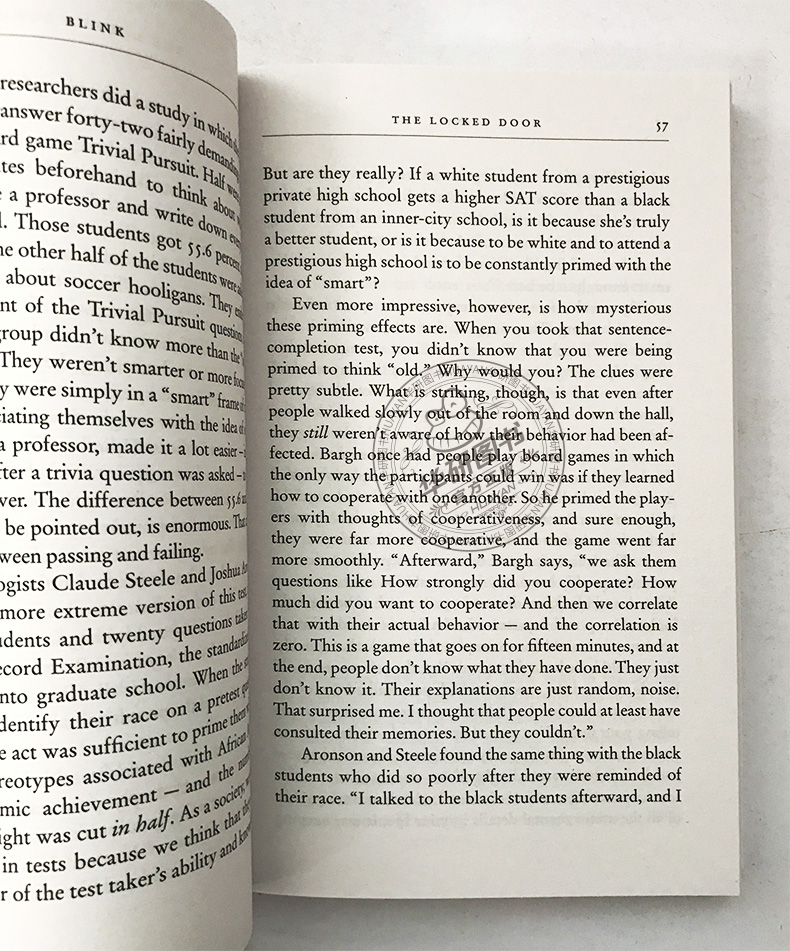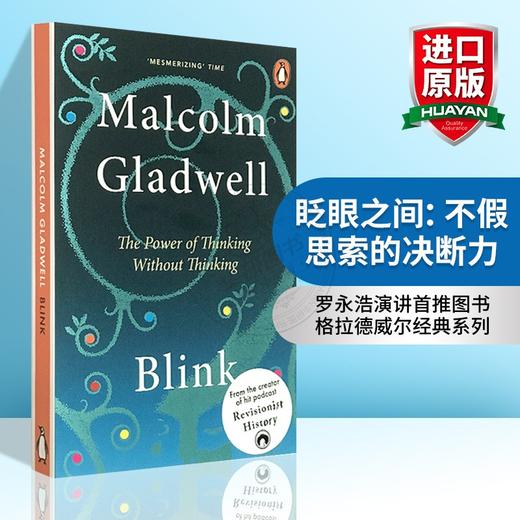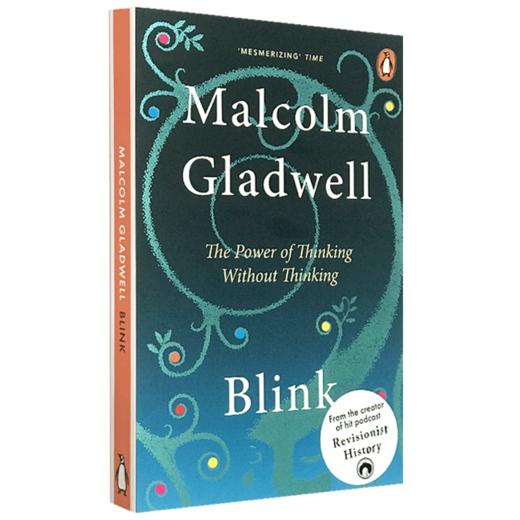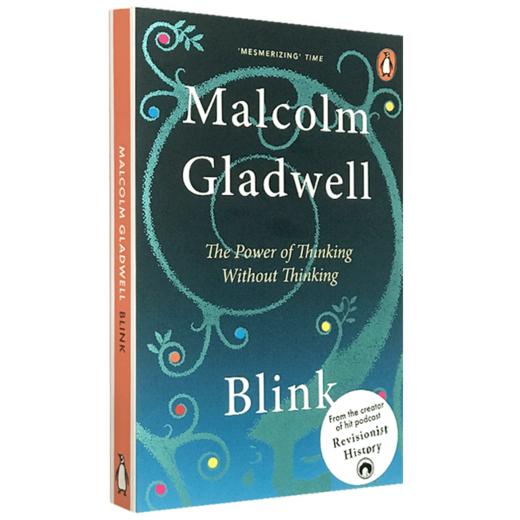眨眼之间 英文原版经济管理书 Blink 不假思索的决断力 英文版进口书籍 决断2秒间
| 运费: | ¥ 0.00-999.00 |
| 库存: | 10 件 |
商品详情




书名:Blink: The Power of Thinking Without Thinking 眨眼之间:不假思索的决断力
作者:Malcolm Gladwell马尔科姆·格拉德威尔
出版社名称:Penguin
出版时间:2006
语种: 英文
ISBN:9780141014593
商品尺寸:12.9 x 1.7 x 19.8 cm
包装:平装
页数:304 (以实物为准)

Blink: The Power of Thinking Without Thinking《眨眼之间:不假思索的决断力》(决断2秒间),作者是马尔科姆·格拉德威尔。生活中的决策无论好坏,我们到底是如何做成的?为什么有些人的决策能力令人称绝?在本书中,格拉德威尔阐述并解答了这些问题。
推荐理由:
1.怪才作家格拉德威尔经典著作全新修订;
2.罗永浩个人演讲首推图书;
3. 英文原版,内容生动有趣,比较容易读懂。
精彩书评
“我只能说近来印象比较深刻的是一个纽约时报的专栏作家写的书,叫马尔科姆·格拉德威尔,他写了几本书,一本书叫《引爆点》,后面又出了《决断2秒间》(即《眨眼之间》),还有《异类》,这个人在国外是一个畅销书作家,都不是小说。在纽约时报排行榜都是排在前几位的,都是谈的一些比较有意思的事情,他从一个比较蹊跷的思路去思考它,所以对人的思维引导很大。” ——罗永浩
“格拉德威尔带领我们遨游于各个学科领域,本书内容精彩纷呈,令人目不暇接。” ——《纽约时报》
“本书实现了读者对格拉德威尔新作的万般期待,展现出葛拉威尔令人印象深刻的注册商标:多样且吸引人的案例,并将各种不同的现象交织成心理实验、解释与令人惊叹的关联性。” ——《华盛顿邮报》
“就像在制造某种传言,你很难不被格拉德威尔说服。不仅因为他能用吸引人的事实来支持他的论调,他也善于以此解释人类行为。” ——美国《商业周刊》
“格拉德威尔是个说故事的天才,他从各种你可以想象到的人们努力心血中找出神奇而有趣的故事。” ——《时代》周刊
An art expert instantly spots a fake. A cop decides whether to shoot. A psychologist accurately predicts a couple’s future in minutes. This book is about those moments when we “know” something without knowing why. It shows that honing your instincts could change the way you think about thinking forever.
Review
“Trust my snap judgement, buy this book: you’ll be delighted” — The New York Times
“Blink might just change your life” — Esquire
“Compelling, fiendishly clever” — Evening Standard

不管是一拍脑袋做出的决定,还是脱口而出的想法,都不是随机事件。不管是快速约会的一见钟情,还是头脑发热的浪漫,都不是年轻气盛。我们在一眨眼之间做出的决定,比三思而后行,或许更具大师级的水准。只是,直觉背后的内涵,远比表象来得深刻。
生活中的决策无论好坏,我们到底是如何做成的?为什么有些人的决策能力令人称绝?在本书中,格拉德威尔阐述并解答了这些问题。他通过多样化的个案,诸如快速约会的过程、流行音乐的运作以及无辜黑人遭警方枪杀的疑案,彰显了一项重大发现:人们在一眨眼间做出的决策,其内涵远比表相来得复杂。
格拉德威尔援引心理学的新研究成果,证实了影响决策优劣的关键,并不在于我们能够快速处理多少信息,而是在于我们全神贯注的专注力。格拉德威尔在各个例证之间纵横挥洒,再度展现了他的精湛才华。他告诉我们在家庭关系、职业生涯到日常生活中,如何成为更成功的决策者。本书将令你有柳暗花明之感,从而改变许多成见与做法,更让你对“直觉思维”的了解迈入新的境界。
Intuition is not some magical property that arises unbidden from the depths of our mind. It is a product of long hours and intelligent design, of meaningful work environments and particular rules and principles. This book shows us how we can hone our instinctive ability to know in an instant, helping us to bring out the best in our thinking and become better decision-makers in our homes, offices and in everyday life. Just as he did with his revolutionary theory of the tipping point, Gladwell reveals how the power of blink could fundamentally transform our relationships, the way we consume, create and communicate, how we run our businesses and even our societies. You’ll never think about thinking in the same way again.

马尔科姆·格拉德威尔(Malcolm Gladwell),出生于英格兰,成长于加拿大,是一个有着牙买加血统的美国人,《纽约客》的怪才作家,被《时代》杂志评为“全球有影响力的100位人物之一”,《快公司》称其为“21世纪的彼得·德鲁克”。他于2011年6月获得加拿大高荣誉“加拿大勋章”。
在他的写作中,融合了科学、社会学及流行文化,并通过原创、清新、有趣的故事来呈现,格拉德威尔是这一写作风格的领军人物。迄今为止,格拉德威尔一共著有4本书,且都是《纽约时报》冠军图书。其作品《引爆点》和《异类》一度创造了书市神话,其中《引爆点》连续28周雄踞《纽约时报》畅销书榜首。他的新图书作品是《小狗看世界》。
因其观点新颖、思想前卫,《纽约时报》把格拉德威尔对社会思潮的影响称为“格拉德威尔效应”(Gladwell Effect)。
Author, journalist, and cultural commentatorMalcolm Gladwellwas born in 1963. He has worked for the Washinton Post and the New Yorker. His bestseller, The Tipping Point captured the world’s attention with its theory that a curiously small change can have unforeseen effects, and the phrase has become part of our language, used by writers, politicians and business people everywhere to describe cultural trends and strange phenomena.

Introduction
序言
The Statue That Didn’t Look Right
别扭的雕像
ONE. The Theory of Thin Slices: How a Little Bit of Knowledge Goes a Long Way
第一章薄片理论:小知识,大不同
TWO. The Locked Door: The Secret Life of Snap Decisions
第二章潜意识密室:瞬间决断的秘密
THREE. The Warren Harding Error: Why We Fall For Tall, Dark, and Handsome Men
第三章沃伦·哈定假象:我们为何会对高挑黝黑的俊男倾心
FOUR. Paul Van Riper’s Big Victory: Creating Structure for Spontaneity
第四章保罗·范·里佩尔之大获全胜:为自发行为定框架
FIVE. Kenna’s Dilemma: The Right—and Wrong—Way to Ask People What They Want
第五章肯纳的窘境:如何了解人们的需求
SIX. Seven Seconds in the Bronx: The Delicate Art of Mind Reading
第六章布朗克斯区的七秒钟:心智解读的精妙艺术
Conclusion. Listening with Your Eyes: The Lessons of Blink
结尾用眼睛倾听:《眨眼之间》教给我们的箴训
Afterword后记
Notes注释
Acknowledgments致谢
Index索引

In September of 1983, an art dealer by the name of Gianfranco Becchina approached the J. Paul Getty Museum in California. He had in his possession, he said, a marble statue dating from the sixth century BC. It was what is known as a kouros—a sculpture of a nude male youth standing
with his left leg forward and his arms at his sides. There are only about two hundred kouroi in existence, and most have been recovered badly damaged or in fragments from grave sites or archeological digs. But this one was almost perfectly preserved. It stood close to seven feet tall. It had a kind of light-colored glow that set it apart from other ancient works. It was an extraordinary find. Becchina’s asking price was just under $10 million.
The Getty moved cautiously. It took the kouros on loan and began a thorough investigation. Was the statue consistent with other known kouroi? The answer appeared to be yes. The style of the sculpture seemed reminiscent of the Anavyssos kouros in the National Archaeological Museum of
Athens, meaning that it seemed to fit with a particular time and place. Where and when had the statue been found? No one knew precisely, but Becchina gave the Getty’s legal department a sheaf of documents relating to its more recent history. The kouros, the records stated, had been in
the private collection of a Swiss physician named Lauffenberger since the 1930s, and he in turn had acquired it from a well-knownGreek art dealer named Roussos.
A geologist from the University of California named Stanley Margolis came to the museum and spent two days examining the surface of the statue with a high-resolution stereomicroscope. He then removed a core sample measuring one centimeter in diameter and two centimeters in
length from just below the right knee and analyzed it using an electron microscope, electron microprobe, mass spectrometry, X-ray diffraction, and X-ray fluorescence. The statue was made of dolomite marble from the ancient Cape Vathy quarry on the island of Thasos, Margolis concluded, and the surface of the statue was covered in a thin layer of calcite—which was significant, Margolis told the Getty, because dolomite can turn into calcite only over the course of hundreds, if not thousands, of years. In other words, the statue was old. It wasn’t some contemporary fake.
The Getty was satisfied. Fourteen months after their investigation of the kouros began, they agreed to buy the statue. In the fall of 1986, it went on display for the first time. The NewYork Times marked the occasion with a front-page story. A few months later, the Getty’s curator of antiquities,
Marion True, wrote a long, glowing account of the museum’s acquisition for the art journal The Burlington Magazine. “Now standing erect without external support, his closed hands fixed firmly to his thighs, the kouros expresses the confident vitality that is characteristic of the best of his brothers.” True concluded triumphantly, “God or man, he embodies all the radiant energy of the adolescence of western art.”
- 华研外语批发分销官方旗舰店 (微信公众号认证)
- 本店是“华研外语”品牌商自营店,全国所有“华研外语”、“华研教育”品牌图书都是我司出版发行的,本店为华研官方源头出货,所有图书均为正规正版,拥有实惠与正版的保障!!!
- 扫描二维码,访问我们的微信店铺
- 随时随地的购物、客服咨询、查询订单和物流...












